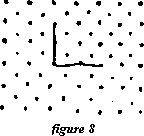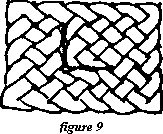Basic Celtic Knotwork Made Easyby Arielle de Brabazon
Here is a method of construction for Celtic knotwork that I learned in a class at TYC. It is period and surprisingly easy, The method consists of drawing a grid of dots and then drawing lines within the sets of dots (as opposed to connecting the dots).
For a simple plait first draw three rows of dots (fig. 2). Next, draw a secondary set of dots within the set of primary dots (fig. 1). Imagine the primary dots in groups of the primary dots in groups of four and put a secondary dot in the center of each square (don't draw in the dotted lines).
Make a pair of parallel lines just inside two pairs of dots as shown in figure 3. Add another pair of lines running perpendicular to the first pair as illustrated. Notice that each group of four dots you use as a guide is diamond shaped and contains two primary and two secondary dots. Continue to add lines as shown (fig. 4). Always start at one point and work outwards. If you start in more than one place, your lines may not meet as they should. To finish the sides and corners, close them up with a slightly curved line (fig. 5).
Here are two blocks of knotwork (fig. 6, 7). Follow the same steps as before. Dots that are an even number both across and down or an odd number both across and down result in several noncontinuous lines. An even number of dots one way and an odd number of dots the other results in one continuous line.
For variety you might try a break in the pattern. Draw your dots and then add one or more interior lines within the pattern (fig. 8). Note that only primary dots can be connected and that breaks do not run diagonally. When you make your lines, treat the break as if it were an exterior line or corner (fig. 9).
An opening can be made in the interior of the knotwork by drawing a square break in the pattern (fig.10). Breaks take a little more practice but are well worth the effort. I hope this information will help untangle the mystery of knotwork for you as it did for me.
 Source:
Source:
George Bain, Celtic Art: The Methods of Construction. Dover, 1973. (ISBN:0486229238)
Back to Early Period #5 |
Back to Early Period Index |
Back to PastTimes











